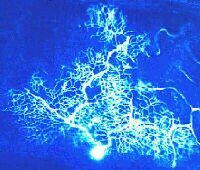X |
|
Gilles
Deleuze's 'polyrhythmic' approach to objectivity
and its impact on the status of concepts as given in VI(b),
above.
|
 Gilles
Deleuze
|
Deleuze's
thinking is resolutely polyglot, ranging to map reality on
reality's own terms. His work fits well into our 'biological' model
of mind as exhibiting modes of linguistic fact
which serve
the plasticity of human needs and desires in maintaining
circulations, disseminations and reproductions of mutating
informational inheritances on a ground of accreting - and also
dissolving - potentially informational structural residues. In Deleuze's writing, descriptions of
segmentations, flows, and lines of flight
characterize
lived patterns in more accord with the language of physical phase
than that of signifying structures. The kind of plurality Deleuze
exhibits is no static domain of 'facts': it emphasizes reality's
active overflow, the excessive productions that subvert or are
repressed by the reigning pretenses of order - if the latter cannot
ignore or make use of them.
|









